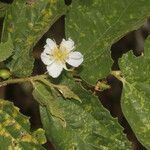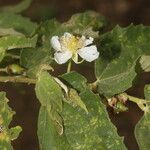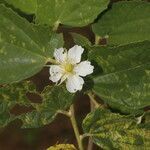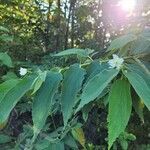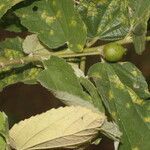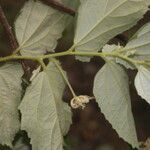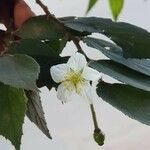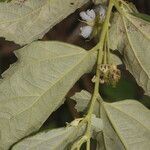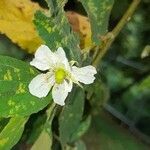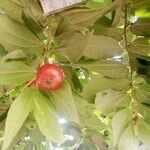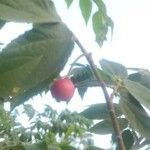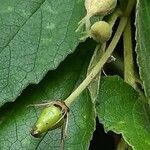Tree to ca 1.0 m tall or shrub; trunk usually slender, the bark black. Leaves alternate; stipules linear, 3-4 mm long, hirsute and glandular pubescent, usually soon caducous; petioles 2-5 mm long, densely hirsute and glandular; blades in-equilateral, 5-11.5 cm long, 1.5-3.5 cm wide, lanceolate to elliptical, firmly mem-branaceous; midrib and secondary veins densely pubescent above, densely hirsute and glandular pubescent, prominent beneath; blade surface glandular, glabrate or with scattered stellate hairs above, densely matted-pubescent and glandular be-neath; base strongly inequilateral, one side sometimes developing into an enlarged flap; apex acute to short attenuate, acute; margin serrate. Inflorescences supra-axillary, usually 1-flowered, infrequently 2-3-flowered; pedicels 1-1.8 cm long, hirsute and glandular-pubescent. Flowers ca 2 cm in diam; sepals 5, 5-7 mm long, 1.5-2 mm wide, lanceolate, long-acuminate, tawny-pubescent without, creamy-white, felty-pubescent within, caducous; petals 5, short-clawed, rhombic-ovate, creamy-white, 7-9 mm long, 5-8 mm wide, the outer margin undulate; stamens o (more than 50), 4-5 mm long, borne on an enlarged hirsute receptacle; filaments slender; anthers ca 0.5 mm long, ovoid, reddish, the anther-sacs dehiscent their full length; pistil 4-5 mm long, nearly hidden by stamens and receptacular hairs; ovary ovoid, narrowing to a very short, thick style, smooth, glabrous, usually 5-loculed with bibbed placentae hanging free from near the top of the axis in each locule and covered on all surfaces with ovules; stigma thick, conical, 5-lobate. Fruit baccate, yellow or dark red and sweet, in the specimens only to ca 8 (-10) mm in diam, surmounted by the persistent stigma, ca 5-loculed (locule walls apparently often displaced by the crowding of the mass of small seeds), the surface granulose; seeds ca 0.5 mm long, 0.33 mm in diam, ovoid, pale yellow.
More
Shrub or mostly small tree 2–9(–12) m tall (rarely more); bark tough; indumentum soft, somewhat viscid, densely velvety, of stellate and glandular hairs.. Leaves oblong to oblong-lanceolate, 5–14 cm long, 2–4.5(–5) cm wide, acuminate at the apex, paler grey beneath; petiole 3–6 mm long with dense tuft of hairs near base; stipules linear, 1.5–5 mm long.. Peduncles 1.2 cm long, becoming 2.5 cm in fruit.. Sepals lanceolate, 8–12 mm long, the filiform tips ± 3 mm long, shorter or longerthan the corolla.. Petals white, broadly obovate, 7–12 mm long, 5–10.5 mm wide.. Ovary flask-shaped, shortly stipitate.. Berries yellow turning red, ± globose, 8–15 mm in diameter.. Seeds yellow, scarcely 0.5 mm long.. Fig. 21.
A small tree up to 5-12 m high. The trunk is 15-20 cm across. Branches are wide spreading and almost horizontal. The young shoots are covered with hairs. The leaves are alternate and elliptical. They are 4-5 cm long and 3-4 cm wide. The leaves are unequal at the base. The leaves have teeth along the edge. The leaf is dark green on top and dull below. The flowers are small and white or cream. They occur as one or two in the axils of leaves. The fruit stalk is 1.5 cm long. The fruit are small red berries 1-2 cm across. They have many tiny seeds. The fruit are edible.
Leaves: petiole 2–5 mm; blade 60–150 × 20–50 mm. Pedicels 5–20(–35) mm. Flowers: 8–12+ mm; petals 12–20 mm. Berries 10–15 mm diam. Seeds 0.4–0.5 × 0.2–0.3 mm. 2n = 28 (Costa Rica), 30 (India).
A tropical plant. It is native to the West Indies and South America. They suit sandy coral soils of low islands. They grow from sea level up to about 1000 m altitude in the tropics. They need a warm, sunny, sheltered position. In Argentina it grows up to 1,000 m above sea level. It suits hardiness zones 10-12. In XTBG Yunnan.
More
Well-drained limestone banks and in thickets at elevations from sea level to 600 metres in Jamaica. A typical pioneer species, colonizing disturbed sites in tropical lowlands.
